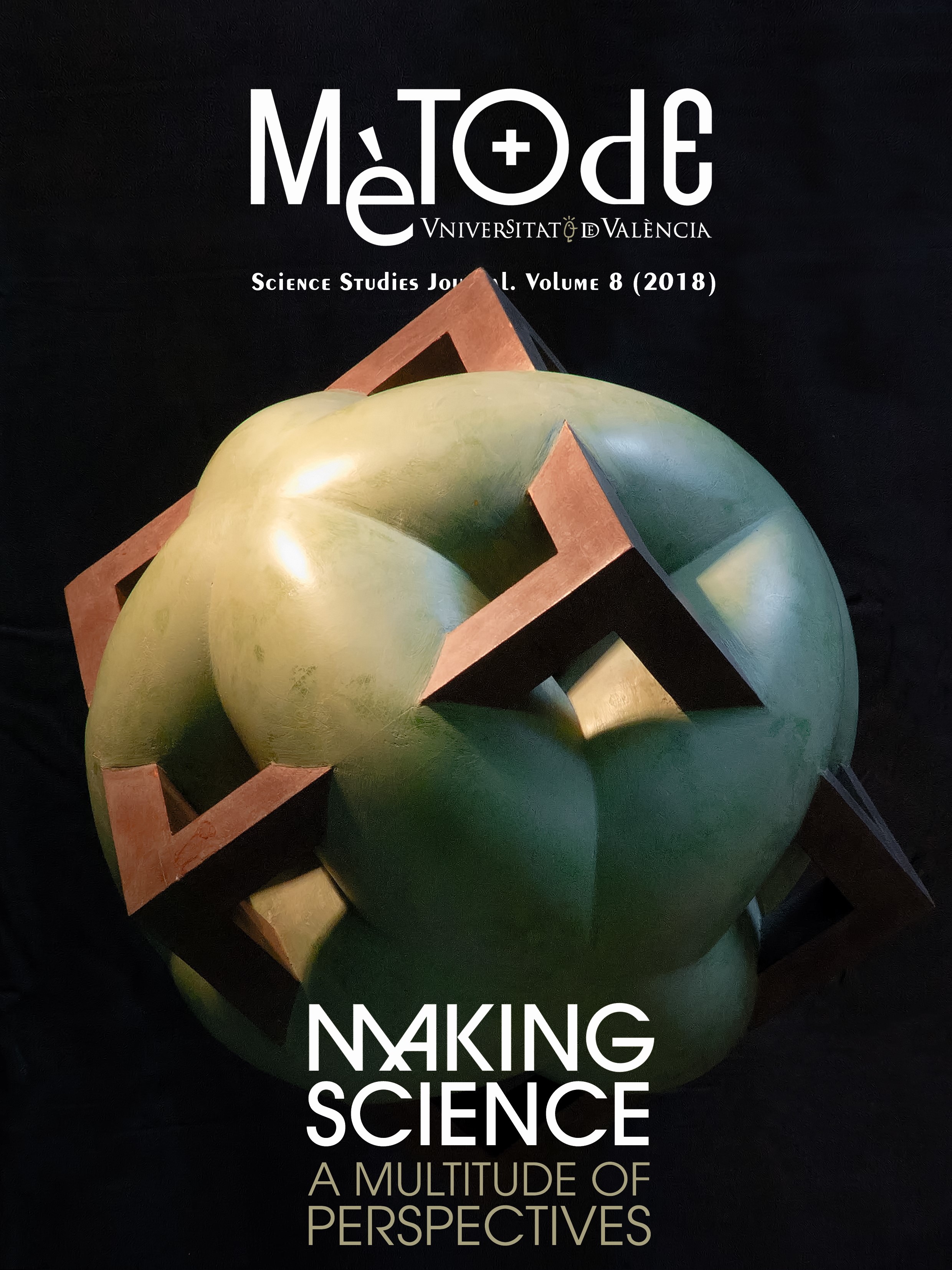Historia y realidad del género ‘Homo’: ¿Qué es y por qué lo consideramos como tal?
DOI:
https://doi.org/10.7203/metode.8.9111Palabras clave:
taxonomía, géneros, género Homo, paleoantropología Resumen
Resumen
Los paleoantropólogos que se ocupan de cómo la naturaleza se organiza en especies y cómo deberíamos denominarlas suelen ser acusados de «limitarse a discutir sobre nombres». Esta idea implica que la taxonomía básica es una tarea administrativa aburrida que se debería solucionar rápidamente, o incluso ignorar, para poder llegar cuanto antes a las cuestiones realmente interesantes sobre la evolución humana. Sin embargo, la realidad es que nunca entenderemos la trama de esa intrincada obra que es la evolución humana si no identificamos con precisión a los actores que participaron en ella. Este artículo revisa la formación del concepto actual de género Homo, que resulta sumamente vago, como trasfondo para instar a realizar una definición más racional.
 Descargas
Descargas
 Citas
Citas
Arsuaga, J. L., Martínez, I., Arnold, L. J., Aranburu, A., Gracia-Téllez, A., Sharp, W. D., … Carbonell, E. (2014). Neandertal roots: Cranial and chronological evidence from Sima de los Huesos. Science, 344, 1358–1363. doi: 10.1126/science.1253958
Collard, M., & Wood, B. (2015). Defining the genus Homo. In W. Henke, & I. Tattersall (Eds.), Handbook of paleoanthropology(2n ed., vol. 3, pp. 2107–2144). Heidelberg: Springer.
Dirks, P. H. G. M., Roberts, E. M., Hilbert-Wolff, H., Kramers, J. D., Hawks, J., Dosseto, A., … Berger, L. R. (2017). The age of Homo naledi and associated sediments in the Rising Star Cave, South Africa. eLife, 6e24231. doi: 10.7554/eLife.24231
Dobzhansky, T. (1944). On species and races of living and fossil man. American Journal of Physical Anthropology, 2, 251–265. doi: 10.1002/ajpa.1330020303
Haeckel, E. (1868). Natürlische Schöpfungsgeschichte. Berlin: Reimer.
Howell, F. C. (1957). The evolutionary significance of variation and varieties of Neanderthal man. The Quarterly Review of Biology, 32, 330–347. doi: 10.1086/401978
Keith, A. (1915). The antiquity of man. London: Williams and Norgate.
King, W. (1864). The reputed fossil man of the Neanderthal. Quarterly Journal of Science, 1, 88–97.
Leakey, L. S. B., Tobias, P. V., & Napier, J. R. (1964). A new species of Homo from Olduvai Gorge. Nature, 202, 7–9. doi: 10.1038/202007a0
Leakey, M. G., Spoor, F., Brown, F. H., Gathogo, P. N., Leakey, L. N., & McDougall, I. (2001). New hominin genus from eastern Africa shows diverse middle Pliocene lineages. Nature, 410, 433–440. doi: 10.1038/35068500
Linnaeus, C. (1758). Systema Naturae(10th ed.). Stockholm: Salvii.
Lordkipanidze, D., Ponce de León, M. S., Margvelashvili, A., Rak, Y., Rightmire, G. P., Vekua, A., & Zollikofer, C. P. E. (2013). A complete skull from Dmanisi, Georgia, and the evolutionary biology of early Homo. Science, 342, 326–331. doi: 10.1126/science.1238484
Mayr, E. (1950). Taxonomic categories in fossil hominids. Cold Spring Harbor Symposia on Quantitative Biology, 15, 109–118. doi: 10.1101/SQB.1950.015.01.013
Mayr, E. (1953). Comments on evolutionary literature. Evolution, 7(3), 273–281. doi: 10.2307/2405739
Oakley, K. P. (1949). Man the toolmaker. London: Trustees of the British Museum.
Robinson, J. T. (1951). Meganthropus, australopithecines and hominids. American Journal of Physical Anthropology, 11, 1–38. doi: 10.1002/ajpa.1330110112
Schwartz, J. H., & Tattersall, I. (2015). Defining the genus Homo. Science, 349, 931–932. doi: 10.1126/science.aac6182
Semaw, S., Renne, P., Harris, J. W. K., Feibel, C. S., Bernor, L., Fesseha, N., & Mowbray, K. (1997). 2.5 million-year-old stone tools from Gona, Ethiopia. Nature, 385, 333–336. doi: 10.1038/385333a0
Sutikna, T., Tocheri, M. W., Morwood, M. J., Saptomo, E., Jatmiko, Awe, R. D., … Roberts, R. G. (2016). Revised stratigraphy and chronology for Homo floresiensis at Liang Bua in Indonesia. Nature, 532, 366–369. doi: 10.1038/nature17179
Tattersall, I. (1993). The human odyssey. Englewood Cliffs, NJ: Prentice-Hall.
Tattersall, I. (2015a). Homo ergaster and its contemporaries. In W. Henke, & I. Tattersall (Eds.), Handbook of paleoanthropology(2nd ed., Vol. 3, pp. 2167–2188). Heidelberg: Springer.
Tattersall, I. (2015b). Defining and recognizing the genus Homo. Gortania, 36, 5–22.
Tattersall, I. (2016). The genus Homo. Inference: International Review of Science, 2(1). Retrieved from inference-review.com/article/the-genus-homo
Theunissen, B. (1988). Eugéne Dubois and the Ape-Man from Java: The history of the first “missing link” and its discoverer. Dordrecht/Boston: Kluwer Academic.
Villmoare, B., Kimbel, W. H., Seyoum, C., Campisano, E. N., DiMaggio, E. N., Rowan, J., … Reed, K. E. (2015). Early Homo at 2.8 Ma from Ledi-Geraru, Afar, Ethiopia. Science, 347, 1352–1355. doi: 10.1126/science.aaa1343
Weidenreich, F. (1939). Six lectures on Sinanthropus pekinensis and related problems. Journal of the Geologicual Society of China, 19, 1–110. doi: 10.1111/j.1755-6724.1939.mp19001008.x
Wood, B., & Collard, M. (1999). The human genus. Science, 284, 65–71. doi: 10.1111/j.1755-6724.1939.mp19001008.x
Descargas
Publicado
Cómo citar
-
Resumen2202
-
PDF 920
Número
Sección
Licencia
![]()
Todos los documentos incluidos en OJS son de acceso libre y propiedad de sus autores.
Los autores que publican en esta revista están de acuerdo con los siguientes términos:
- Los autores conservan los derechos de autor y garantizan a Metode Science Studies Journal el derecho a la primera publicación del trabajo, licenciado bajo una licencia de Creative Commons Reconocimiento-NoComercial-SinObraDerivada 4.0 Internacional, que permite a otros compartir el trabajo con un reconocimiento de la autoría del trabajo y citando la publicación inicial en esta revista.
- Se permite y se anima a los autores a difundir sus trabajos electrónicamente a través de páginas personales e institucionales (repositorios institucionales, páginas web personales o perfiles a redes profesionales o académicas) una vez publicado el trabajo.





